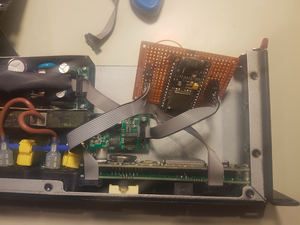Difference between revisions of "Powerbar NG hardware"
(Created page with "{{Project |picture=APC-ESP8266.PNG |ProjectSkills=electronics, software, network, notbeingonfire |ProjectStatus=Planning |ProjectNiche=Electronics |ProjectPurpose=Infrastructu...") |
|||
| Line 11: | Line 11: | ||
However, there's a few issues with the current implementation that would be good to address. | However, there's a few issues with the current implementation that would be good to address. | ||
Mainly: | Mainly: | ||
| − | + | * There's quite a considerable delay between command-and-result | |
| − | + | * The powerbars are 'fickle' to keep connected to | |
| − | + | * The powerbars only have serial, neccesitating some 'box' to interface with them | |
| − | + | * There are , afaik, no spares.. A dead bar would be a problem at this point | |
| − | + | * There are only two bars, requiring long cabling for devices not conveniently located closeby | |
A solution has been found in the availability of a considerable amount of APC 7921 PDU's which are being phased out at a $dutch_ISP, making them relatively easily available. | A solution has been found in the availability of a considerable amount of APC 7921 PDU's which are being phased out at a $dutch_ISP, making them relatively easily available. | ||
| Line 26: | Line 26: | ||
ToDos at this point: | ToDos at this point: | ||
| − | + | * Research if Current Transformer can be used 'as is' in esphome | |
| − | + | * Prototype schottky-diode setup for combining Dual PSU 24VDC in the device | |
| − | + | * Design an approach for monitoring PSU-status on the ESP | |
| − | + | * Choose an approach for the LAN connectivity. Home-brew or pre-made module | |
| − | + | * Choose controller for driving 2-digit display. | |
| − | + | * Choose an approach for 24DC-> 3.3V conversion. | |
| − | + | * Create schematic/PCB | |
| − | + | * Decide upon software. ESPHome seems viable candidate that provides all required | |
Extra benefits expected from the new hardware: | Extra benefits expected from the new hardware: | ||
| − | + | * Easier method of knowing state of any outlet, at any time | |
| − | + | * Integration with existing automation-frameworks are more straight-forward (HomeAssistant comes to mind) | |
| − | + | ** Enables adding non-powerbar-based outlets/lamps to be included more easily (Hue, Tradfri, Xiaomi, Sonoff) | |
| − | + | ** Allows telemetry/sensoring to be added via one infrastructure, one API) | |
Revision as of 13:28, 8 October 2020
| Projects | |
|---|---|

| |
| Participants | |
| Skills | electronics, software, network, notbeingonfire |
| Status | Planning |
| Niche | Electronics |
| Purpose | Infrastructure |
The space has relied heavily on two serially connected powerbars that provide a large number of switchable sockets used for hooking up devices/lamps to so that they are conveniently turned on/off via powerbar.ti infra. This infra is what the powerbutton(s) next to the door also talk to.
However, there's a few issues with the current implementation that would be good to address. Mainly:
- There's quite a considerable delay between command-and-result
- The powerbars are 'fickle' to keep connected to
- The powerbars only have serial, neccesitating some 'box' to interface with them
- There are , afaik, no spares.. A dead bar would be a problem at this point
- There are only two bars, requiring long cabling for devices not conveniently located closeby
A solution has been found in the availability of a considerable amount of APC 7921 PDU's which are being phased out at a $dutch_ISP, making them relatively easily available. The units currently thrown out are in various states of defect, however. Mainly PSU or controller-issues. The good thing is that there seems to be an easy fix for the controller. The relay electronics interface well against an ESP8266/ESP32
So far, the following has been done: - Documentation has been written about the internals of the APC 7921 - A first PoC of an esp8266 board running ESPHome has been created that succesfully interfaces to the relay-board via i2c
ToDos at this point:
- Research if Current Transformer can be used 'as is' in esphome
- Prototype schottky-diode setup for combining Dual PSU 24VDC in the device
- Design an approach for monitoring PSU-status on the ESP
- Choose an approach for the LAN connectivity. Home-brew or pre-made module
- Choose controller for driving 2-digit display.
- Choose an approach for 24DC-> 3.3V conversion.
- Create schematic/PCB
- Decide upon software. ESPHome seems viable candidate that provides all required
Extra benefits expected from the new hardware:
- Easier method of knowing state of any outlet, at any time
- Integration with existing automation-frameworks are more straight-forward (HomeAssistant comes to mind)
- Enables adding non-powerbar-based outlets/lamps to be included more easily (Hue, Tradfri, Xiaomi, Sonoff)
- Allows telemetry/sensoring to be added via one infrastructure, one API)